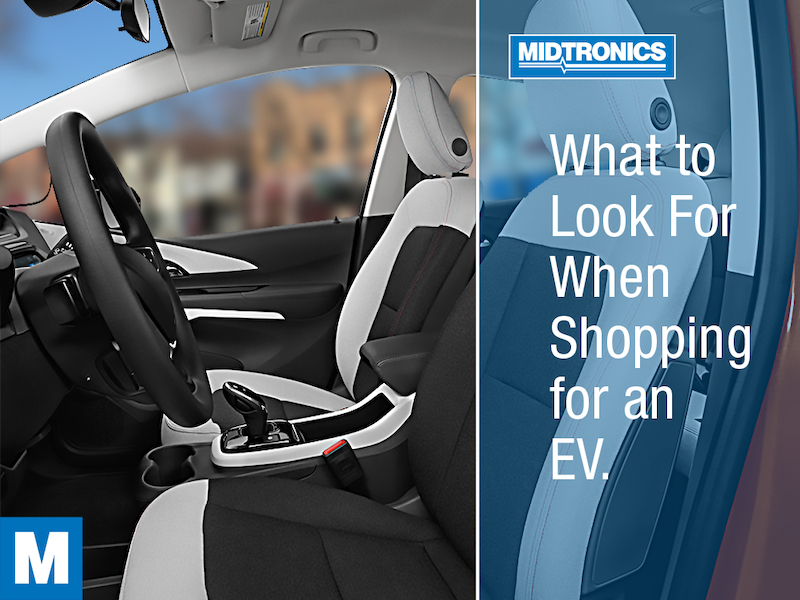Every week, there’s new about emerging electric vehicle technology or an EV that’s coming to market soon. It’s expected that EVs will make up the majority of vehicle sales by the year 2030. And with that increased adoption will come more selection, vehicle variations, and of course, performance.
When the time comes to shop for your new electrified vehicle, what should you look for? There are some stark differences between gas-powered cars and EVs, and you should go into the experience with the best knowledge possible.
Here are the top four things you should look in an EV.
1. Range
Electric cars are becoming more and more popular, with good reason. They’re cheaper to operate than gas cars, they emit no pollutants, and they have a smaller environmental impact overall. But one of the main factors that is holding people back from making the switch to electric vehicles is range anxiety – the fear that the car will run out of power before reaching their destination. People worry that they won’t be able to find a place to charge their car when they need it, or that they won’t be able to drive far enough without having to stop and recharge.
But as electric vehicle technology improves, this is becoming less and less of a problem. Many new EVs can now travel for 250 miles or more on a single charge, which is plenty for most people’s needs. And as public charging infrastructure continues to grow, range anxiety will become less and less of an issue.
If you’re commuting less than 30 miles each way and you’re able to charge your EV at home, then a standard-range electric car will suit your purpose fine – and at the lower end of the price range. If you commute longer distances or you plan on travelling extensively, opt for a long-range model with 350 miles of range or more.
2. Price
Electric vehicles have been on the market for a few years now, but they still haven’t caught on with the general public. They are more expensive to buy than traditional gas-powered cars, but the cost of ownership is much lower in the long run. In fact, over the course of five years or so, an electric car can save you thousands of dollars compared to a traditional car.
The price of electric cars varies widely, from around $30,000 to well over $100,000. The cost of the car itself is just one part of the total price. You’ll also need to factor in the cost of maintenance on any mechanical components and the batteries as well as charging equipment.
When you’re shopping for an EV, a good plan is to perform a cost comparison between a similar ICE vehicle and the EV you’re exploring to find where the annual cost of ownership balances out.
3. Charging time
Electric cars take anywhere from 30 minutes to 12 hours to fully charge, depending on the model and type of charger you have, and even longer if you use a household plug. Maximize your charge by plugging your vehicle in while you’re at the shopping mall or the office, but it’s going to be important to plan your charges out. Otherwise, you might be in line for a 30-minute charge at a busy DC fast charging station with a battery that’s nearly discharged.
If you don’t have access to a charging station at home or work, you’ll need to find one that’s compatible with your car. There are several types of chargers available, so be sure to do your research before buying one.
Types of Chargers
There are two main types of chargers: standard AC chargers and DC fast chargers. Standard AC chargers, or Level 1 chargers, plug into a regular 110V outlet like your phone charger and can take 50 to 70[TS1] hours to fully charge a car battery. Level 2 chargers are much quicker but still take several hours to bring a battery from 20% to 80%. DC fast chargers, or Level 3 chargers, use a higher voltage and can charge batteries in as little as 30 minutes, but they’re not as common yet.
New tech is constantly coming to market for charging. If the fastest possible charging is important, look for a vehicle compatible with 800-volt chargers that can trim ‘re-fueling’ times by more than half.
4. Size and Weight
When shopping for an electric vehicle, size and weight are important factors to consider. Electric cars come in a variety of sizes, from small city cars to large SUVs. However, the larger the car, the more battery power it will require and the longer it will take to charge, but there may be constraints on where you can park. Some new EV trucks are too wide to utilize a standard parking stall, for example.
Weight is also important to consider. Heavier cars require more energy to move and therefore use more battery power. What that also means is the cost rises significantly since the batteries need to be bigger to get a feasible range. And when an EV truck or SUV is tipping 10,000 pounds or more, there may be restrictions on parking in certain garages.
It looks like electric vehicles will be the predominant vehicle on the roads in the not-so-distant future, and your options will expand rapidly. Whether you’re in the market for an EV now or in a few years’ time, these areas are a great starting point for your shopping experience.




